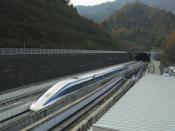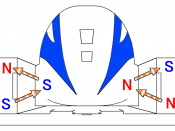"We may perhaps learn to deprive large masses of their gravity and give them absolute levity, for the sake of easy transport."
- Benjamin Franklin
1.0 INTRODUCTION
In many major world cities, such as Los Angeles, it can take up to 3 hours to cross a city by automotive, and by the time you reach your destination it can take a further hour to find a park. To combat this problem, a mode of transport that didn't involve these parking hassles had to be used. Busses and trains both came to be used, although trains more so for their speed and lack of need to use a public road. Since they first were used trains have evolved in technology and sophistication.
Wagonways (Figure 1) were in use in Germany from as early as 1550. These primitive railed roads were comprised of wooden rails, over which horse-drawn carts or wagons moved with more ease than they did over dirt roads.
These wagonways were the first phase of modern railroads.
Fig.1
By 1776, iron had replaced the wood in the rails and wheels on the carts. Wagonways then evolved into Tramways, and spread throughout Europe, although horses still pulled the vehicles. Later in 1789, William Jessup designed the first wagons with flanged wheels. The flange was a channel that allowed the wheels to achieve a better grip on the rail. This was a critical design, which has carried over to locomotives.
More recently, in the 1960s and early 1970s, considerable interest developed in the possibility of building trains that could travel notably faster than conventional trains. "From the 1970s, interest in an alternative high-speed technology centred on magnetic levitation, or maglev" (Internet 7), although the concept of using magnets to float trains and have them fired down a track has been around...


